The United States’ trade deficit with China narrowed significantly following the imposition of additional tariffs on imports from China in multiple waves beginning in 2018—or at least it did based on U.S. trade data. Chinese data tell a much different story, with the bilateral deficit rising nearly to historical highs at the end of 2020. What’s going on here? We find that (as also discussed in a related note) much of the decline in the deficit recorded in U.S. data was driven by successful efforts to evade U.S. tariffs, with an estimated $10 billion loss in tariff revenues in 2020.
There Was an Unprecedented Shift in the Trade Balance Discrepancy after 2018
The U.S.-reported bilateral trade deficit with China during the decade prior to 2018 was on average about $95 billion larger than the deficit implied by China’s reported trade surplus with the United States, and this discrepancy had been consistently positive for several decades. However, this statistical gap narrowed significantly with the onset of the U.S.-China trade conflict in 2018, and even reversed sign in 2020, as shown in the left panel of the chart below. This narrowing was driven almost entirely by disagreement in the statistics between growth rates in U.S. imports from China as reported by the United States, and what the Chinese data say China was exporting to the United States. As a result, for the first time ever, China’s reported exports to the United States had become larger than U.S.-reported imports from China in 2020, as indicated in the right panel of the chart. Hereafter, the “trade data gap” will refer to U.S.‑reported imports from China minus China’s reported exports to the United States.
Three major factors have traditionally accounted for gaps in China’s trade with its trading partners. The most well-known, and the one traditionally most important for the United States, involves trade through Hong Kong, in which re-exports of Chinese origin are correctly reported in U.S. import statistics as being from Mainland China, but are not shown in Mainland China’s exports to the United States. However, incorporation of Hong Kong’s trade into this analysis does not change the basic picture shown in the chart.
Two other factors that have been extensively studied in China’s trade involve the misreporting of Chinese exports in response to changes in value-added tax (VAT) policies in China, and the misreporting of import statistics to avoid tariffs. Other probably less important factors that could have driven the shift in the U.S.-China trade data gap include routing trade through third countries to avoid the “made in China” label, in which there might be disagreement between national statistical authorities on the country of origin of the U.S. imports; misreporting by firms engaging in arms-length trade; or Chinese firms trying to circumvent Chinese capital controls by inflating export figures.
Misreporting of trade to avoid taxes would appear to be highly relevant given that the United States imposed huge tariff increases on China and that China responded with sweeping VAT tax policies. From the U.S. side, it seems clear that U.S. importers faced incentives to minimize tariff tax liabilities by finding ways to underreport import values from China, perhaps utilizing low-ball invoices provided by their Chinese suppliers. After all, the United States’ tariff hikes against China increased average tariffs on the country from 3 percent in mid-2018 to a peak statutory rate of 17.5 percent in September 2020, as illustrated in the blue line in the next chart.
The role of Chinese VAT policies is less well-understood and rather complex (more detail is available in our related note). In a nutshell, unlike most countries, China does not fully “rebate” value-added taxes on exports—meaning that China effectively imposes export taxes—and its exporters correspondingly face incentives to underreport exports. These rebate rates vary by product category, and historically have been adjusted to affect macroeconomic or industrial policy goals. Higher VAT rebate rates (in other words, lower export taxes) reduce incentives to under-invoice. In addition, firms that sell both domestically and externally have long been known to engage in illicit tax minimization by overreporting exports in order to gather VAT rebates; the value of these schemes rises when rebate rates are increased. In fact, in response to U.S. tariff actions, China engaged in four sweeping waves of increases in rebate rates (reductions in export taxes), as illustrated by the red line in the chart below. As a result, the share of export products facing zero net VAT rates increased dramatically from 5 percent of all goods in 2017 to about 50 percent by the end of 2019. The net effect of these VAT policy changes was to incentivize increases in reported export values from China, both through less under-invoicing and through outright over-invoicing.
We therefore believe there are plausible reasons to expect to see changes in misreporting patterns of imports and exports, both of which would be in the direction of explaining at least some of the shift in the trade data gap. Overall trade balance flows in fact are consistent with such a view. Because changes in Chinese VAT rebates apply equally to all Chinese export destinations, the observed shift in the China-reported trade data gap with the United States should also occur with other Chinese export partners. The left panel of the chart below shows that indeed this is the case. On the other hand, U.S. tariff hikes against China were bilateral, so the shift in the discrepancy in U.S.-reported trade data should just be largely a U.S.-China bilateral phenomenon. The right panel of the chart confirms this, with the gray dashed line the same as the red dashed line in the left panel and the gold line showing no matching trend in the calculated data gap for U.S. trade with the rest of the world.
Quantifying the Effects of Misinvoicing and Adjusting the Trade Discrepancy
In an effort to quantify these effects, we consider differences in the behavior of four categories of goods. Namely, we look at goods affected by the VAT rebate, by the U.S. tariffs, by both, and by neither. In this way, we estimate that 17 percent of the decrease in the trade data gap is due to efforts to evade U.S. tariffs and 13 percent is due to changes in VAT rebate rates. In value terms, these estimates translate to the following breakdown for explaining the $88 billion decrease in the U.S.-China trade data gap by the end of 2020: (1) $55 billion due to evasion of U.S. tariffs, (2) $12 billion due to overreporting or decrease in underreporting of Chinese exporters to China Customs, and (3) $20 billion due to other reasons.
Determining where the adjustment for misreporting should be made—whether it be in the U.S.-reported or China-reported data—requires some level of judgment. Given the administrative process for U.S. tariff collection, we make the plausible assumption that the evasion of tariffs most likely shows up as underreporting of Chinese imports to U.S. Customs Border Protection rather than a distortion in the data reported by China Customs. We thus add $55 billion back to the U.S.-reported value of imports from China. The impact of changes in VAT rebate rates that increased export overreporting and/or lowered underreporting almost certainly shows up in data reported by Chinese authorities. Thus, we subtract $12 billion from the reported Chinese exports to the United States. These adjustments are shown in the left panel below.
Once we make these adjustments to the U.S.- and China-reported data, the trade data gap between the two series looks much more similar to the historical gap. Did the U.S.-China bilateral deficit narrow or remain at historical size? The truth appears to be that it did narrow somewhat, but not to the extent indicated by the U.S.-reported data (see the right panel of the chart). It therefore seems clear that the trade conflict had a much smaller impact on the U.S. bilateral trade balance with China than first meets the eye when looking at U.S. data.
Finally, these calculations allow us to estimate by how much import underreporting at the U.S. border may have reduced U.S. tariff revenue. Customs duties rose from $35 billion in 2017 to $66 billion in 2020. Taking our estimate of missing imports and an estimated tariff rate on these goods suggests that around $10 billion of tariff revenue may have been lost in 2020 as a result of import underreporting.
 Hunter L. Clark is an assistant vice president in the Federal Reserve Bank of New York’s Research and Statistics Group.
Hunter L. Clark is an assistant vice president in the Federal Reserve Bank of New York’s Research and Statistics Group.
Anna Wong is a principal economist at the Board of Governors of the Federal Reserve System.
How to cite this post:
Hunter L. Clark and Anna Wong, “What Happened to the U.S. Deficit with China during the U.S.-China Trade Conflict?,” Federal Reserve Bank of New York Liberty Street Economics, June 18, 2021, https://libertystreeteconomics.newyorkfed.org/2021/06/what-happened-to-the-us-deficit-with-china-during-the-us-china-trade-conflict.html.
Related Reading
COVID-19 Has Temporarily Supercharged China’s Export Machine
How Has China’s Economy Performed under the COVID-19 Shock?
Disclaimer
The views expressed in this post are those of the authors and do not necessarily reflect the position of the Federal Reserve Bank of New York or the Federal Reserve System. Any errors or omissions are the responsibility of the authors.










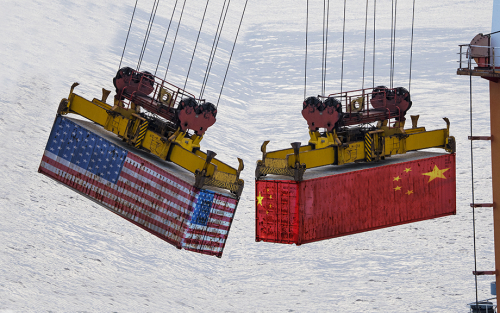
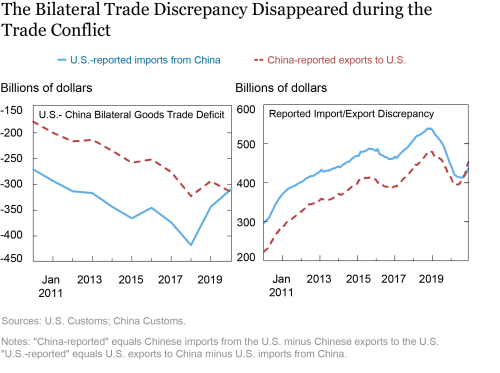
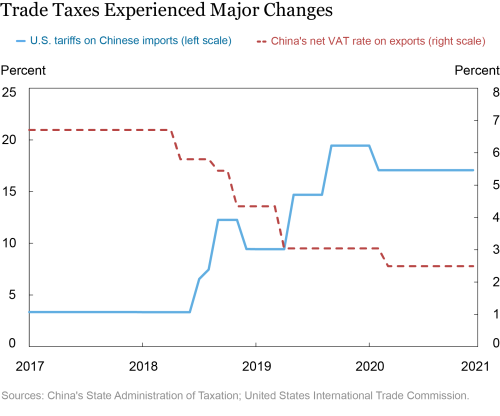
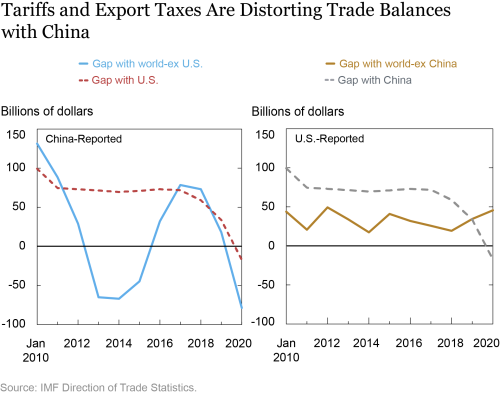
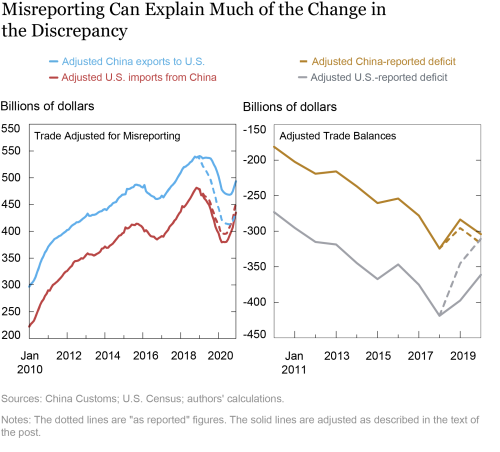
 RSS Feed
RSS Feed Follow Liberty Street Economics
Follow Liberty Street Economics